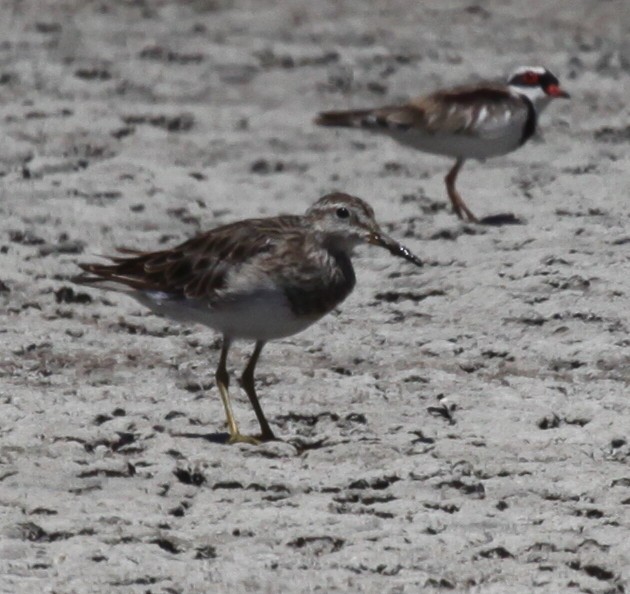Pectoral Sandpiper
A species of Calidris Scientific name : Calidris melanotos Genus : Calidris
Pectoral Sandpiper, A species of Calidris
Botanical name: Calidris melanotos
Genus: Calidris
Content
Description General Info
 , used under CC-BY-SA-3.0 /Cropped and compressed from original
, used under CC-BY-SA-3.0 /Cropped and compressed from original Description
The pectoral Sandpiper is a small, migratory bird that's hard to miss with its unique chestnut underparts and sturdy build. Every year, it embarks on a long journey between its breeding and wintering grounds, often stopping along shorelines where it feasts on tiny creatures in the mudflats and shallow water. Despite its compact size, the Pectoral Sandpiper is a strong and nimble flier, able to brave harsh conditions and fly long distances with ease. Seeing one of these birds is a testament to the incredible journeys that many species undertake. 
Size
20-23 cm (8-9 in)
Life Expectancy
5-5.9 years
Nest Placement
Ground
Feeding Habits
Pectoral Sandpiper feed by picking and probing in mud for invertebrates, utilizing sight and touch. They favor vegetation-rich wetlands for foraging, mainly consuming insects like crane fly larvae, midges, beetles, as well as spiders, seeds, and algae. Their diet also includes crustaceans, various bugs, and sometimes small fish.
Habitat
Pectoral Sandpiper's habitat includes wet coastal tundra for breeding, emphasizing grasses and sedges. During migration, they are drawn to wetlands such as marshes and muddy shores across North America, also adapting to man-made habitats. In non-breeding seasons, pectoral Sandpiper occupy South American freshwater wetlands and pastures or Australian saline habitats, showcasing the species' adaptability to varied wetland ecosystems.
Nest Behavior
Females of pectoral Sandpiper select and prepare the nesting site. They utilize natural depressions, which they shape using their feet and breast, followed by lining with vegetation. Nesting activities are focused on raised, dry areas, with breeding occurring during the short Arctic summer.
Nest Characteristics
Pectoral Sandpiper build nests on the ground, often on raised areas like hummocks or ridges, occasionally sheltered by vegetation. The nest is a depression formed and lined with grass, sedges, lichen, moss, and leaves, measuring 4 inches tall with a 3.3-inch-wide and 2.2-inch-deep cup.
Dite type
Aquatic invertebrate eater
General Info
Feeding Habits
Bird food type
Sounds
Call
Recording location: United States
Call
Recording location: United States
Song
Recording location: United States
Song
Recording location: United States
Behavior
Pectoral Sandpiper's engage in a compelling, complex display of courtship rituals. Males establish territories upon arrival in the tundra, conducting elaborate aerial displays punctuated by unique, resonant calls. They captivate females with an intricate dance, inflating their chests and vocalizing high-pitched sounds. Unlike many species, there is no pair bond; females solely manage nesting and offspring rearing. Post-mating, males depart, and females later lead the young, joining other pectoral Sandpiper's in coastal foraging before migrating. Males' and females' notable size disparity is evident during group migration.
Distribution Area
It is a very long-distance migrant, and about half of the species breeds in the boggy tundra of northeast Asia, the rest nesting in a range from Alaska to central Canada. The American and most of the Asian birds winter in South America, but some Asian breeders winter in southern and Australia and New Zealand. On migration and in winter, the pectoral sandpiper is typically found in freshwater habitats. This species also occurs as a regular migrant to western Europe, and is seen most years in Ireland or Great Britain. While the pectoral sandpiper has not been recorded as breeding species in Europe, vagrant individuals were found in Scotland in suitable breeding habitat during summer. Many of the birds occurring in Western Europe may be on a regular migration from Asian breeding grounds to winter in Southern Africa. September 2003 saw a record influx to those two countries, with 40 found in Ireland and 150 in Great Britain. On the US Pacific coast, such stagings of migrant flocks appear to be rarer. Vagrant individuals are sometimes seen elsewhere off the usual migration routes, e.g. on the Marianas, the Marshall Islands and Palau in Micronesia; they are somewhat more frequently encountered on the Hawaiian Islands. The pectoral sandpiper's migration might be affected by global warming, as is suspected for many Arctic-breeding birds: 100 years ago, migrating pectoral sandpipers were observed to pass through northern Ohio in early-mid May and again in late August; today, the bulk of the northward migration takes place in April already, and most birds do not return until mid-September. These birds forage on grasslands and mudflats, picking up food by sight, sometimes by probing. They mainly eat arthropods and other invertebrates. The male has a courtship display which involves puffing up his breast, which has a fat sac in the breeding season to enhance his performance. The pectoral sandpiper builds a steep-sided scrape nest with a considerable volume of lining material. The nest is deep enough that the eggs sit about 3 cm (1.2 in) below ground level, which helps to minimize heat loss from the cool breezes which occur at the latitudes where the species nests. The female lays four eggs. Pectoral sandpipers have decreased in number 50% since 1974. 
Species Status
Not globally threatened.
Scientific Classification
Phylum
Chordates Class
Birds Order
Shorebirds Family
Sandpipers Genus
Calidris Species
Pectoral Sandpiper